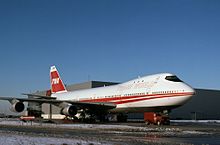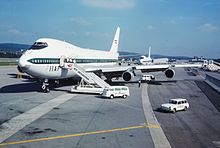Imperial Iranian Air Force Flight 48
| Imperial Iranian Air Force Flight 48 | |
|---|---|
|
An identical Boeing 747-131 (F) of the Imperial Air Force of Iran |
|
| Accident summary | |
| Accident type | Tank explosion after lightning strike |
| place | near Madrid , Spain |
| date | May 9, 1976 |
| Fatalities | 17th |
| Survivors | 0 |
| Aircraft | |
| Aircraft type |
|
| operator |
|
| Mark | 5-283 |
| Departure airport |
Tehran Mehrabad Airport , Iran |
| Stopover |
Madrid-Barajas Airport , Spain |
| Destination airport |
McGuire Air Force Base , New Jersey , United States |
| Passengers | 7th |
| crew | 10 |
| Lists of aviation accidents | |
On May 9, 1976, a serious aircraft accident occurred on Imperial Iranian Air Force Flight 48 (flight number: ULF48 ) in which a Boeing 747-131F of the Iranian Air Force crashed near Madrid in Spain as a result of a lightning strike. All 17 people on board the machine died in the incident.
Machine and occupants
The aircraft involved in the accident was a Boeing 747-131 (F) which was five years and eight months old at the time of the accident. The machine was assembled at the Boeing plant in Everett , Washington State , and made its maiden flight on September 15, 1970. The aircraft had the factory number 19677, it was the 73rd Boeing 747 from ongoing production. In September 1970 the aircraft was newly delivered to Trans World Airlines , where it went into operation with the aircraft registration number N53111 . On October 15, 1975, the machine was taken to the Boeing plant in Wichita , Kansas , where it was converted to a cargo aircraft. As part of the conversion, a large cargo hatch was retrofitted on the left side of the fuselage. In the same month the machine was taken over by the Iranian Air Force , where it received its new aircraft registration number 5-283 . The four-engined wide - body aircraft was equipped with four Pratt & Whitney JT9D-7A engines. The last maintenance was carried out on May 4, 1976.
There were 17 occupants, all members of the Imperial Iranian Air Force, on board the machine. Ten of them were listed as crew members and seven as passengers.
Flight history
The military cargo flight should lead from Tehran to McGuire Air Force Base in the state of New Jersey in the USA , with a stopover at Madrid-Barajas airport . The machine took off from Tehran at 8:20 a.m. UTC (11:50 a.m. local time). The takeoff weight of the machine was 276,827 kg, 115,500 kg of which was due to the kerosene in the tanks. After taking off, the machine rose to a cruising altitude of 9400 meters.
At 2:15 p.m., the crew reported to air traffic control and informed them that they were expected to arrive at 2:40 p.m. At 14:19, the air traffic controller on duty informed the pilots that the aircraft had appeared on the radar. At 2:22 p.m. UTC (4:22 p.m. local time) the crew was informed of the weather conditions at the airport and at 2:25 p.m. UTC was given clearance to descend from 27,000 feet (approx. 8,230 meters) to 10,000 feet (approx . 3050 meters). The pilots confirmed receipt of the radio message.
On that day a low pressure area with thunderstorms had passed over Spain. When the aircraft approached, however, visibility was good and the weather service had issued no warnings. At 2:30 p.m., the aircraft deviated from its planned flight route to the left due to bad weather. At 14:32 UTC, air traffic control gave clearance to descend to 5000 feet (approx. 1500 meters). The air traffic controller instructed the crew to contact approach control. At 14:33 UTC (16:33 local time), the crew contacted approach control and reported that the weather conditions on the aircraft's flight path had deteriorated. The pilots therefore applied to deviate from their planned approach route again. The approach control air traffic controller informed the crew that he had just made radio contact and asked for the instruction to be repeated. The crew confirmed receipt of the radio message and announced that they were currently flying over the Castejon radio beacon . The air traffic controller instructed the pilots to maintain a course of 260 °. The crew confirmed and reported that they had sunk to 5,000 feet (1,500 meters). This was the last radio message from the machine.
the accident
Around the same time, residents south of Valdemoro were watching the machine. The crew was aware that they were flying into a bad weather front, but nobody in the cockpit expressed their concerns until finally at 14:34 UTC a crew member said: “We are in the middle of the brew!” Seconds later, two eyewitnesses on the ground saw how Lightning struck the machine, causing the left wing to explode. This destruction began near engine number 1. The wing began to flutter massively and was then torn apart into three large parts, which soon fell apart into 15 pieces. At this point, the flight data recorder stopped recording while the voice recorder continued to record the noises in the cockpit. The beep of the shutdown of the autopilot could be heard, which suggests that the pilots shut it down. Unaware that the left wing had torn off, the pilots tried in vain to regain control of the machine. The out-of-control machine went into a dive and crashed 54 seconds after the lightning strike at 14:35 UTC (16:35 local time) in a field about 900 meters above sea level.
Accident investigation
The accident was investigated by the National Transportation Safety Board . It was found that lightning had struck near the cockpit and emerged again in the area of a surge arrester at the end of the left wing. Sparks formed in the left wing tank, which at that time contained 11,230 kg of kerosene. The spark caused fuel vapors to explode in the tank, with the pressure wave destroying the kerosene tank in the wing. Most likely, the spark had passed over from the wiring to the tank due to the overvoltage. Part of the wing was torn off the machine by the explosion. In addition, part of the fuselage was damaged. This changed the airflow suddenly, which led to the wings being stretched considerably. At this point in time, the machine was flying through a zone with turbulence at high speed, so that the wing was exposed to high loads. Seconds later, the entire left wing tore off. Ultimately, the investigators could not clarify whether the wing was torn off by the explosion or the mechanical stress.
According to the relevant research literature on the effects of lightning strikes on commercial aircraft, the Imperial Iranian Air Force's Boeing 747-131F (SCD) 5-283 is the largest commercial aircraft that has been shown to have been torn apart after being struck by lightning in midair .
See also
Individual evidence
- ↑ a b c accident report in the Aviation Safety Network
- ↑ Brief description of the incident on lightningsafety.com
- ↑ Operating history of the machine on planespotters.net .
- ↑ a b c d e f Accident Report (PDF) , Federal Aviation Administration
- ↑ a b c Lawyers link TW 800 loss to Iran air force 747 explosion , Flight International of October 9, 1996.
- ↑ a b c d Rakov, Vladimir A .; Uman, Martin A. (2003): Lightning. Physics and Effects. Cambridge University Press, pp. 365f.
- ↑ a b c d e f g h i Special Investigation Report - Wing Failure of Boeing 747-131, Near Madrid, Spain, May 9, 1976 , Final Report of the National Transportation Safety Board
- ↑ Wegner, Mark; Norris, Guy (2009): Boeing 787 Dreamliner, Zenith Press, p. 117.
- ↑ Uman, Martin A. (2008): The Art and Science of Lightning Protection, Cambridge University Press, pp. 164f.


